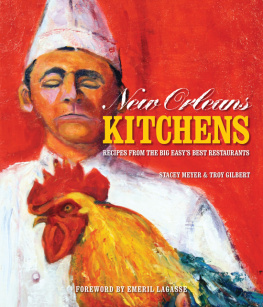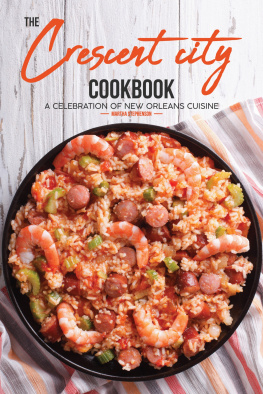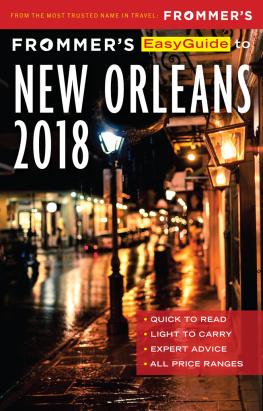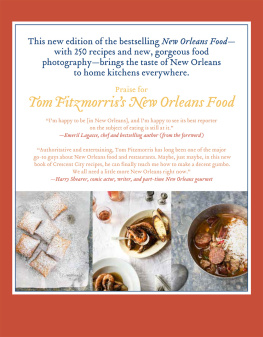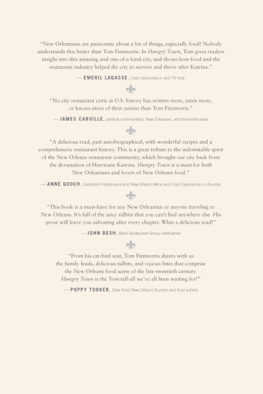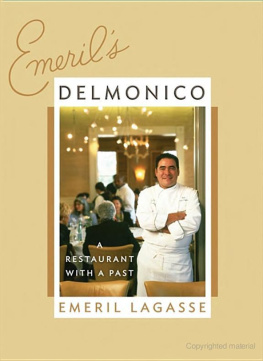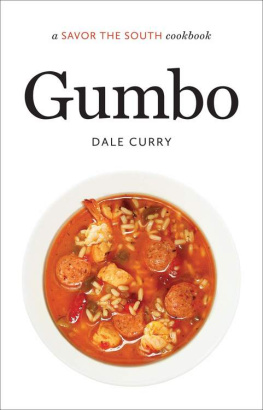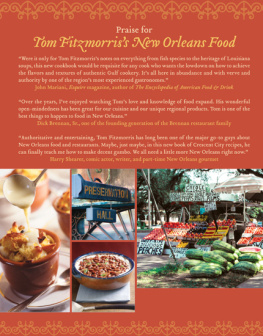Staceys mom, Mary Ann Meyer, for being a great supporter, for contributing recipes, for testing recipes, and for being there during all the craziness.
Stephen Domas for his editorial skills and for his support.
Alyson Peters for submitting recipes and testing recipes for me.
Ken Berke for his amazing photographs of the art workwe should have used some of his photos as well.
Anna Minges for helping gather all of the images from The Ogden Museum and all of her hard work. She is an amazing woman.
Rick Gruber, one of the most knowledgeable people we have met regarding Southern art.
Leslie Spillman from Soren Christensen, Christy Wood and Denise R. Berthiaume from LeMieuxremarkable effort, Jonathon Ferrara for Art Docs, and Donna Cavato for The Edible Schoolyard Gardens. Not to mention, all the artists, galleries, and chefs who participated in this book.
Foreword
By Emeril J. Lagasse III
When most people think of New Orleans, they think food, fun, and frivolity, with the madness of Mardi Gras and Bourbon Street coming to mind first and foremost. But when you take the time to scratch the surface even just a bit, however, or if your visit to this fair city enables you to linger a while and take in everything that the Big Easy has to offer, you quickly see that not only is there this fun and delicious element always simmering around town, but also so much more that is part of the fabric of everyday life here. What is it about this city that inspires the artist in all of us, whether chef, author, painter, or musician?
These are thoughts that I sometimes ponder, many years after New Orleans called to me to make my home here. Over the years I have fallen in love with the city in many different waysand the love affair continues. When I first arrived here almost thirty years ago, it was the food that called me, but once here it was the people and the joyful way that New Orleanians live life that cemented the union. My craft as a cook grew more and more inspired as I learned some of the secrets of the bold, flavorful Creole and Cajun cooking. The architecture and pulse of the rich art scene in the Warehouse District was a natural home to my first restaurant venture, and the community embraced me much as I had their city. Years later, with much history behind us all, I still keep coming back to the beat of this incredible city, which truly feels like home to me in a way no other place ever has.
I invite you to take a stroll through the city with meher tastes, her visions, her music, her inspirations and aspirations, by exploring the pages of New Orleans Kitchens. My good friend Stacey Meyer has knocked on many doors and has assembled some truly delicious recipes and gems of the local art scene to share a little bit of the magic of the city with us all.
Come see a bit of what the Crescent City is all about...
Introduction
New Orleans is known as The Crescent City. Shaped like a crescent and nestled on the banks of the Mississippi River, it was originally settled by the Spanish and French, and their influence is still reflected today in its culture, cuisine, and architecture. Throughout the nineteenth and twentieth centuries, people from France, Italy, Ireland and Germany, and more recently Vietnam, emigrated to the city, each bringing with them their unique heritage and traditions. In many ways, New Orleans is the melting pot of the South. It is a city that has a rich history and its diversity is reflected in its music, cuisine, arts, and architecture. As a port city, people of all walks of life flowed in and out of the community. Historically, the South was mainly rural with just a few cosmopolitan cities. New Orleans, Charleston and Savannah were the centers for arts and culture, but New Orleans had more of a Bohemian quality. New Orleans has always been considered the true southern mecca for musicians, writers, and artists. Its sultry and romantic atmosphere beckons quirky characters drawn to its allures. Artists draw inspiration from its landscape, architecture and people, while chefs draw inspiration from its unique and diverse cuisine and natural bounty of seafood or produce. Artists, musicians, writers, and chefs are all stimulated by the sense of community in New Orleans and are inspired by each other.
Southerners and Northerners alike flock to New Orleans for its music festivals; the Jazz and Heritage Festival being the main draw. Music is an inherent part of the citys soul with its gospel brunches and jazz funerals. In the spring, just before Mardi Gras, you can hear the high school brass bands practicing before performing in the parades. Walking through the French Quarter, trumpets and saxophones resonate in the street. New Orleans is famous for jazz and blues, but all forms of music can be found emanating from its many clubs and bars. There are endless venues for music, including such iconic establishments as Tipitinas and the Maple Leaf. Like everything else in New Orleans, its music has its own unique style and rhythm.
The cuisine of New Orleans is unlike anywhere else in the world. It is deeply rooted in the diverse heritage of the city. Jambalaya, for example, is a rice dish made with shrimp, chicken, and sausage, reminiscent of its Spanish culinary cousin paella. While gumbo is heavily influenced by the citys West African heritage, other famous dishes such as beignets and Trout Meunire Amandine come from France. With so many cultures converging in one spot, it is no wonder the food is as diverse and unique as it is delectable. Another key factor to the citys famous foods is the resources New Orleans and southern Louisiana have available. The Gulf of Mexico provides shrimp, blue crabs, and an endless list of fish. Louisiana cultivates more oysters than anywhere else in the country. The more exotic ingredients like alligator, crawfish, and frogs legs are also cultivated throughout southern Louisiana. This state is also known as sportsmans paradise, where hunting and fishing are not just sports, but ways of life passed down through generations. There are innumerable cookbooks published in Louisiana dedicated to wild game that provide recipes for ducks, doves, venison, rabbits, squirrel, and possum. Fruit trees are grown in gardens and backyards throughout New Orleans. Pecan trees grow throughout the state, and rice and sugar cane are agricultural staples.
Louisiana natives love these heritage foods and the chefs of New Orleans prominently showcase them in their restaurants. New Orleanians love to eat, cook, and talk about food. It is an integral part of the citys culture.

